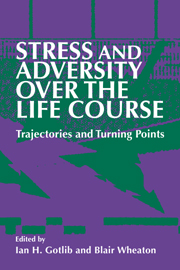Book contents
- Frontmatter
- Contents
- List of contributors
- 1 Trajectories and turning points over the life course: concepts and themes
- I Trajectories: long-term effects of adverse experience
- II Turning points: changes in life trajectories
- 8 Becoming unsupervised: children's transitions from adult-care to self-care in the afterschool hours
- 9 Children whose parents divorce: life trajectories and turning points
- 10 Life after high school: development, stress, and well-being
- 11 Turning points in midlife
- 12 Adaptation to retirement
- III New methods for the study of the life course
- Index
12 - Adaptation to retirement
from II - Turning points: changes in life trajectories
Published online by Cambridge University Press: 23 October 2009
- Frontmatter
- Contents
- List of contributors
- 1 Trajectories and turning points over the life course: concepts and themes
- I Trajectories: long-term effects of adverse experience
- II Turning points: changes in life trajectories
- 8 Becoming unsupervised: children's transitions from adult-care to self-care in the afterschool hours
- 9 Children whose parents divorce: life trajectories and turning points
- 10 Life after high school: development, stress, and well-being
- 11 Turning points in midlife
- 12 Adaptation to retirement
- III New methods for the study of the life course
- Index
Summary
Retirement is one of several turning points of aging. Others include health failure that leads to restrictions in activity and to dependency, deaths of contemporaries that diminish community, and the death of a spouse, from which follow grief and loneliness. Among the turning points of later life, only retirement is not unmitigated loss.
In the past 50 years there have been several large-scale and many smallerscale studies of satisfaction with retirement. The studies suggest strongly that retirement can be either burden or boon; in every study, substantial proportions of respondents are dissatisfied with retirement and substantial proportions are satisfied. Dissatisfaction with retirement is reported to characterize from a fifth of respondents (Barfield & Morgan 1978) to a third (Shanas et al. 1968) to somewhat more than a third (Streib & Schneider 1971). Satisfaction with retirement is reported to characterize from about a third of retired men and women (Atchley 1976; Streib & Schneider 1971) to somewhat more than a third (Palmore et al. 1985).
Professionals and high-level managers may be the occupational groups for whom retirement is most sharply a turning point. It is in these occupational groups that career is best established and also that investment in work appears to be strongest. More than members of other occupational groups, professionals and managers are likely to say they would continue to work even without financial necessity (Morse & Weiss 1955).
- Type
- Chapter
- Information
- Stress and Adversity over the Life CourseTrajectories and Turning Points, pp. 232 - 246Publisher: Cambridge University PressPrint publication year: 1997
- 5
- Cited by



